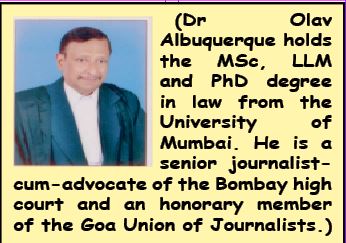By Dr Olav Albuquerque
AS Catholics throughout Goa observe Good Friday which is a day of fasting and penance, because it was on this day that Jesus Christ laid down his life so that mankind was redeemed in the eyes of God, news channels continue their intermittent 24 x 7 cycle broadcasting. Good Friday is celebrated throughout all churches in Goa and India.
Midnight mass is held on Saturday night with Catholics gathering together on Easter eve to pay homage to Jesus Christ for His death and resurrection on holy Sunday. Many may know it but Easter is more important than Christmas because it was on this day that Jesus Christ arose body and soul from the tomb in which his body was buried. Christianity began with this miracle because few know that Jesus walked with his disciples, felt the pangs of hunger and told St Thomas to put his hands in His (Jesus’) wounds and feel them. It was after this experience that St Thomas fell on his knees and declared: “My Lord and My God!”
Declaring to the universe that Jesus Christ was indeed a God-made man born of virgin birth, crucified. He died in the flesh and rose in the flesh to proclaim that death had died and mankind was saved due to his death and resurrection.
The story of Jesus Christ can be summed up in the fact that Jesus was born of the virgin Mary, he grew up as a normal child, proclaimed the word of God in the last three years of his life between the ages of 30 years and 33 years before he was crucified, rose in the flesh and ascended into heaven.
It is this same zeal for souls that propelled the Franciscans to accompany the Portuguese to come to Goa in 1510. They were followed by the Jesuits in 1542 and the religious society was founded by St Francis Xavier who came to be known as Goencho Saib. The Dominicans entered Goa in 1548. The Christianization of Goa roused the passion of these hoary missionaries in the 1540s and after that because it was they who brought the first printing press to Goa to spread the word of God by printing the Bible.
PASSIONATE MESSAGE
THE Franciscans, the Jesuits and the Dominicans, were so passionate about spreading the message that Jesus Christ was God and born and crucified so that mankind would be saved, that the first wave of missionaries beginning with the Franciscans, continued with the Jesuits and the Dominicans in 1548.
The Portuguese had to divide the religious jurisdiction of Goa between the Franciscans, Jesuits and Domincians. While Bardez was entrusted in the care of the Franciscans, Salcette was handed over to the Jesuits who with the Dominians also shared Ilhas. Much later, the Augustinians arrived in Goa in the year 1572.
We must remember that in those distant times, the concept of secularism as we know it today did not exist and the ruling Portuguese, also staunch Catholics, identified governance with Jesus Christ and ruled in his name, so that they felt it was their duty to ensure the message of Jesus Christ was spread far and wide to all those who came into contact with them. Those who were converted to Catholicism embraced a new lifestyle where women were treated on par with men, daughters had equal inheritance with their brothers.
This was an egalitarian concept because in the old holy texts of both the Muslims and Hindus, women and men were not treated equally. The concept of a daughter inheriting land and houses from their male forefathers on par with their brothers, was anathema to texts such as the Manusmriti. Hence, the arrival of St Francis Xavier in 1542, followed by the acquisition of the seminary of Santa Fe in 1544, paved the way for the influx of a number of Jesuits into Goa.
In the 1500s and 1600s the Jesuits were arguably the youngest religious order which was growing rapidly in Europe. This was simply because the Jesuits were seen as educators because they had studied in the Sorbonne in Paris and had acquired what we would now equate with post-graduate or doctoral degrees from Goa University. The Roman Catholic head of church, the pope, and most of the European monarchs were inclined to favor the Jesuits who followed in the footsteps of Jesus Christ and who alone adored him as their Master and Preceptor.
These Jesuits were undoubtedly scholars with three of them being present in Mughal Emperor Akbar’s court to record for posterity the working of the court. Their zeal for souls, and their manner of working invited the admiration, envy and ire of the populace, so that due to diabolical politics and dissension in Portugal, they were expelled from Goa in 1759.
SALCETTE CHURCHES
THERE is no doubt that 25 churches in south Goa, known as Salcette, were built by the Jesuits. They were master architects, engineers and craftsmen, who knew how to draw an architectural plan and execute it by using local material such as laterite stones, to build the magnificent churches which dot the villages in south Goa today.
These churches have something that is intrinsically Jesuit – the inscription HIS traceable and easily identifiable in most of the 25 churches which these Jesuits built. The drawing of a dove either in the façade or above the main altar above the scene of the Pentecost testifies to the devotion and expertise of these Jesuits in building these ancient churches.
As the bells of these churches ring for the faithful to enter their portals for midnight mass on Easter Sunday, we cannot but be grateful to these hoary theologians who knew the Bible, apart from theology to construct magnificent monuments to the glory of Jesus Christ.

